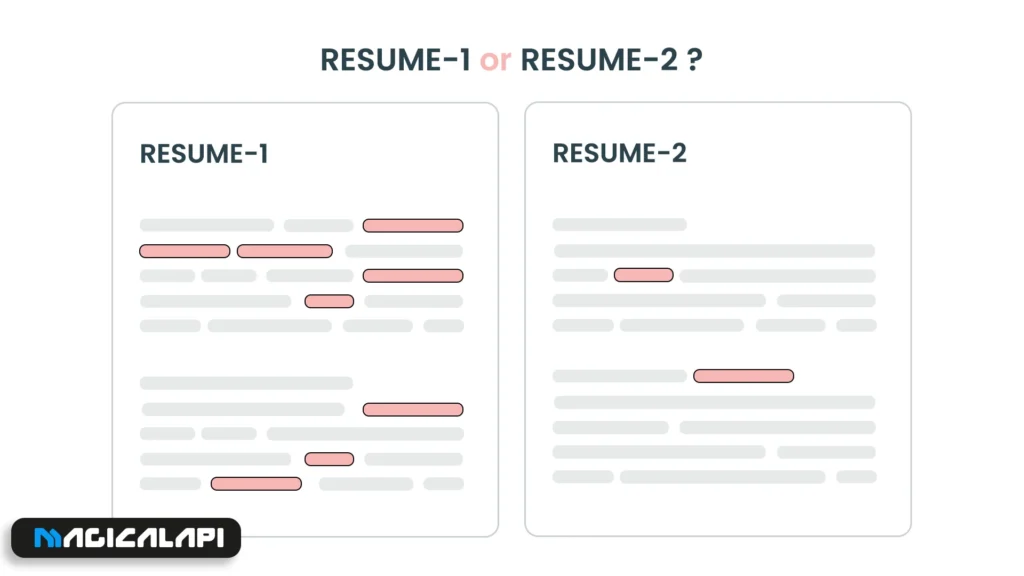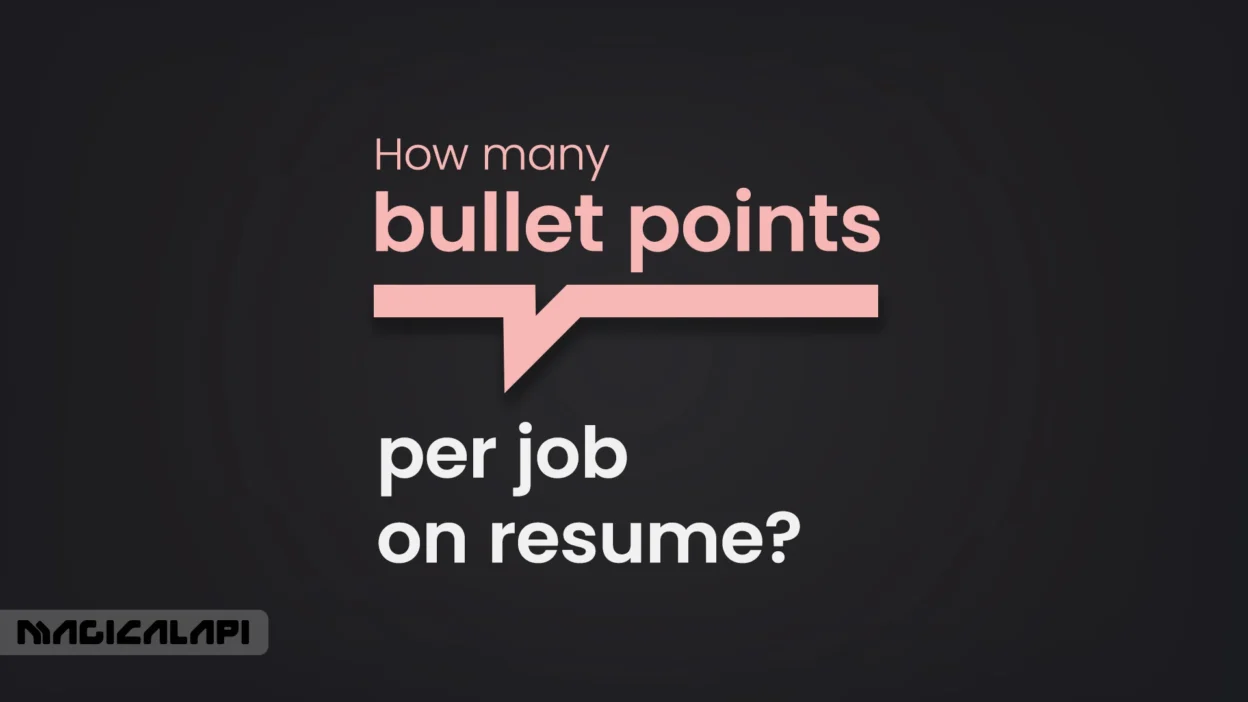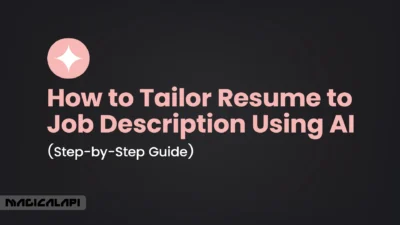Writing the right resume can sometimes feel like a tightrope walk. You want to show the recruiter adequate detail on your skills and achievements, but at the same time, you want to avoid presenting them with a wall of text. A question we hear often from job seekers is, “Just how many bullet points per job on resume?”
Such a great question. The number of bullet points is a very effective way to direct a hiring manager’s attention and tell your professional story. There isn’t a magic number of bullet points per job on resume that is right for every person and every job, but there is a set of very obvious, effective strategies to guide you from a mediocre resume to an interview-generating resume.
In this guide of how many bullet points per job on a resume, we will cover everything you need to know about deciding how many bullet points per job on resume to write, how to maximize the impact of each bullet, and how to avoid common mistakes.
Table of Contents
How many bullet points should you include per job on a resume?
Let’s be frank. The best and most widely accepted advice is to strive for 3 to 6 bullet points per job listed in the work experience section of your resume. Three to six bullet points allow you to provide enough detail that captures the reader and they don’t feel overwhelmed because of a long list of detailed bullet points per job on resume.
That said, that doesn’t mean it isn’t a rule of thumb and not a statute. The number of bullet points per job on resume is fundamentally based on a few things: the relevance of the job to the position you’re applying for; how long ago you held the job; and your total years of experience.
You are not meant to list out tasks – you are meant to convey the most relevant and noteworthy accomplishments for each different role, and the depth of detail you provide will vary with what the employer wants to see.
There’s no magic number, but a good guideline is 3 to 5 bullet points per position. Think of each bullet as a spotlight, if it doesn’t highlight something valuable, it doesn’t belong.
For roles that are less relevant to the job you’re applying for, keep it short with 2–3 bullets that capture only the essentials. For jobs that directly align with your target role, expand to 6 or even 7 points if you have strong, distinct achievements worth showcasing.
Ideal number of bullet points for each work experience

You should not treat all your past jobs equally when you optimize your résumé. Some jobs will warrant more of your résumé than others. Some jobs are better left off a résumé. Think of your résumé as a document of strategy where you have control of your own story. You want to devote the most space to jobs where you can demonstrate that you are the right person for this job.
Here’s a more detailed breakdown of the approach you can take:
- Most Current Relevant Role: 5-8 bullet points. This is your prime real estate. It’s your most current role and reflects the highest level of responsibility you’ve had in the past. You’ll need to give this role the most detail to express your capabilities.
- Previous Relevant Roles (past ten years): 3-6 bullet points each. These roles reflect the core of your professional experience and should clearly support your career trajectory.
- Older or Less Relevant Roles (greater than ten years): 1-3 bullet points per job on resume for the each position. Although these jobs help to document a full work history, they shouldn’t take up a lot of your resume header space. Highlight one or two major accomplishments.
- Short-Term or Contract Jobs: Usually this would only need 1-2 bullet points per job on resume that convey the major project or outcome that you were hired to deliver.
Magical Resume Score
Discover everything you need to know about Magical Resume Score , how it evaluates your resume, and the various options available to enhance your job application and improve your chances of success.
Why 3–6 bullet points per job is the resume sweet spot
Recruiters are busy folks. Studies indicate that they only spend a few second on the first pass of a resume. The distraction of wording and experience length is 3 to 6 bullet points, the perfect number for suggested experience to achieve effortless readability. That readability is possible because of the limited number of bullet points. Realistically, 3-6 bullet points per job on resume will provide better overview of your role and key contributions. Here’s why:
- Maximizes Readability: A list format that conveys information simply is far easier to skim. This allows the hiring manager to quickly comprehend the scope of your role, and take note of your contributions. If your resume looks more like a paragraph with Too many bullet points per job on resume, then appears very dense, probably even intimidating, and likely you will be passed by.
- Prioritizes Your Achievements: You cannot list every single thing you did, so your are narrowed to only listing your most impressive, relevant, and quantifiable achievements. This self-editing helps you to write a strong resume. Instead of describing formally a task in the work context of “managed social media”, you will have chosen something like “Grew organic Instagram engagement to up 200% in 6 months through a new content strategy.”
- It Shows Strong Communication Skills: Knowing what to include and what to omit shows you are able to clearly and effectively communicate essential information vs. non-essential information, which is a very valuable soft skill in any position.
- It Generates Interest: A well written, concise series of bullet pointed facts offers a powerful, compelling, snapshot of your value, while still providing the recruiter with only enough information to want to know more when you come for an interview. It doesn’t tell the whole story. It acts as a great teaser.
What Do Recruiters Really Think About Your Bullet Points?
Thinking like a recruiter can be very revealing. Recruiters aren’t reading your resume for entertainment; they are searching for evidence. Evidence that you can solve their company’s issue or provide for their department’s need. Here’s what they see:
- They are searching for keywords and the numbers: Recruiters eyes are trained to jump to keywords in the job description and metrics that demonstrate impact ($, %, common correlations). bullet points per job on resume are a great mechanism for succinctly summarizing previous experience and contextualizing the value of your past work for job seekers to see.
- Too little (1-2 for a major role): you smell like trouble. Recruiter might think you didn’t have enough impact in the role, you don’t have that much to show for it or you just didn’t care to do this in your application.
- Too much (8+): you smell like trouble. Recruiter might think you can’t prioritize or you are just regurgitating/yanking the entire job description. They are getting exhausted in searching for what matters about your experience.
- The “just right” amount (3-6): demonstrates that you are a strategic thinker. You have thought through your experience and subsided it into what matters to their need, therefore making it easier for the recruiter and making you immediately a strategic candidate.
How to decide how many bullet points to use for each role
Strategic planning is key. Don’t guess how many bullet points per job on resume to create. Use this straightforward technique to adapt your resume for each application.
- Analyze the Job Description: Print a copy of the job description for the role you’ve identified. Take a highlighter, and highlight the applicable skills, qualifications, and responsibilities the employer has spelled out. These things are your targets.
- Organize Your Accomplishments: Go through your employment history, one position at a time, and brainstorm everything you can remember doing. Consider the projects you led, the challenges you faced, and the results you produced.
- Find Connections: Now, match your accomplishments to the highlighted requirements in the job description. The experiences that are best matched are the most valuable for this job application.
- Assign Bullets Based on Relevancy: The position you would like a match the most with should, generally, get the most bullets (likely in that 5-8 range). For positions where your experiences do not have as much relevancy, limit it to 1-3 of your accomplishments to highlight. This is the crux of tailoring your resume.
When to use more vs. fewer bullet points on a resume
Having the theory down is awesome, but now let’s consider some real examples.
Use MORE bullet points (e.g., 5-8) WHEN:
- It’s Your Current or Most Recent Job: It’s your most recent experience, therefore it gets the most detail.
- The Role is Very Relevant: If an earlier job is a nearly perfect job match to the one you are applying for, devote more to it, no matter how long ago it was.
- It Was a Long-Term Role with Ascension: If you were with a company for 5+ years and there was evidence of you advancing in responsibilities, you are allowed to use more bullet points per job on resume to show that upgrade. You can even break it into two sub-headings (e.g., Senior Manager and Manager) within the same company experience.
- You are a Senior-Level Candidate: Executives and senior managers need more space to lay out the complexities of multiple accomplishments, complexities of leadership scope, and strategic initiatives.
Use FEWER bullet points per job on resume (i.e. 1-3) When:
- The Job is Over 10 Years Old: Technology, processes and entire industries change. Although you experienced it, it is part of your history, and is less relevant as an employer considers what you can do for them today.
- The Role is Not Directly Relevant: If you are a software engineer now, your college job as a barista should not have six bullet points per job on resume. One bullet point about customer service would be plenty.
- You Are Trying to Save Space: If you’re trying hard to get your resume to one (or two) pages, the first and best place to trim bullets is from older and less relevant jobs.
Do all jobs on your resume need the same number of bullets?
Not at all! Actually, having the same number of bullet points per job on resume for each position is a serious misstep.
Thinking about it from a visual standpoint, whenever a recruiter picks up your resume, they will read it top down. Meaning that as they are reading, their eye will be drawn to whatever section has more text. By having a different number of bullet points per job on resume, you are creating a visual hierarchy that is telling the recruiter, “Look here! This is the most important stuff.”
For example, if your job as a Project Manager from 2022 has six bullet points per job on resume detailing your work on the project and your role as an Assistant from 2015 only has two, you are silently, effectively and convincingly telling the hiring manager, which job is most relevant to your career path. A uniform approach flattens out your resume and does not highlight a visual hierarchy for the reader.
Tailoring Bullet Points for Applicant Tracking Systems (ATS)
Before even considering the chance that a person will look at your resume, it is probably going to be scanned by a hiring company’s Applicant Tracking System (ATS) which searches your resume for keywords and phrases from the job description to rank candidates. It is important to note the ATS does not “count” your bullet points per job on resume but by using a 3-6 bullets comparison opportunity, you naturally get a chance to use these necessary keywords. Each bullet is another opportunity to incorporate a skill or qualification that the ATS is searching for. Rather than just “keyword stuffing” a single sentence, this is much more effective.
Your focus should be to incorporate keywords from the job description into your achievement-focused sentences. A good-quality resume checker is a great way to go about it. Many can scan your resume against a specific job description and provide suggestions for missed keywords, allowing you to get past the robots and into human hands.
Magical Resume Checker
Discover the full potential of the Magical Resume Checker and explore the various options available to enhance your resume, optimize it for applicant tracking systems (ATS), and improve your chances of landing your dream job.
Tips for writing impactful bullet points without overloading
Indeed, the number of bullet points per job on resume is important, but it’s the quality that really sells. Here is how to ensure you get the most out of each one.
- Start with an Action Verb: *Never* start a bullet with “Responsible for…” or “Duties included…”. Think action verbs: Spearheaded, Orchestrated, Overhauled, Streamlined, Ran, Negotiated, Calculated, Forecasted, Decreased, Accelerated.
- Use the CAR formula: Frame your achievements using the Challenge, Action, Result method. What was the issue (Challenge)? What did you do about it (Action)? What was the output (Result)? For example, “Overhauled the quarterly reporting process (Action) to automate data entry which decreased errors by 95% and saved an average 20 hours of monthly manual work (Result).”
- Quantify Everything: This is the most important tip. Numbers are the language of success. They give you indisputable evidence of what you accomplished. Go through your experience and find anything you can quantify:
- Instead of: “Managed a large budget.”
- Try: “Managed a $2.5M annual operating budget, consistently delivering projects 10% below budget.”
- Instead of: “Increased website traffic.”
- Try: “Led a content marketing strategy that increased organic website traffic by 150% within 12 months.”
- Be Concise: Each bullet should ideally be one line and no longer than two lines. Be ruthless in cutting out the fluff.
After you’ve written your bullet points per job on resume, running your document through a tool that can provide a Resume Score can give you objective feedback on its overall strength and impact.
Common mistakes with bullet points in work history sections
It is important to know what not to do. Avoid these common mistakes:
- The Vague Generalization: “Improved team morale”, “was a good team player.” These terms are subjective and mean nothing in the absence of context or evidence.
- The List of Tasks: Only list your day-to-day tasks (e.g., “Answered phone calls”, “Filed paperwork”, “Answered emails”). This shows a recruiter what you were assigned to do, not what you achieved.
- The Long Bullet Point: A single bullet point that is, in reality, a three or four-line paragraph. If it is that long, you need to condense the item or make two bullet points per job on resume.
- Inconsistent Tense: Past jobs are described in the past tense, while your current role should be in the present tense.
- Overuse of Buzzwords: Terms like “hardworking,” “innovative,” or “detail-oriented” don’t prove anything on their own. They can come across as filler words unless backed by measurable achievements. Always tie buzzwords to evidence.
- Too Many Bullets: Overloading a single job with 10–12 bullets dilutes your impact. Aim for 4–6 strong, results-oriented points per role. Quality beats quantity.
- Lack of Action Verbs: Starting bullet points with “Responsible for” or “Duties included” sounds passive. Begin with strong action verbs like “Led, Improved, Designed, Increased” to show initiative and ownership.
- Ignoring Relevance: Including irrelevant details like “Organized the office holiday party” may show involvement but doesn’t prove you’re qualified for the job. Focus only on bullets that align with the role you’re applying for.
- Using Pronouns: Writing “I managed a team of five” is unnecessary. Resumes should be concise and written in implied first person without pronouns.
- No Metrics or Outcomes: The biggest mistake is failing to include numbers. Saying “Improved sales” is weaker than “Increased sales by 18% in Q2 by launching targeted campaigns.” Numbers add credibility and make your achievements tangible.
Conclusion: How many bullet points per job on resume
Ok, so how many bullet points per job on resume are ideal? While the 3-6 guideline offers a starting point, the real answer is based on strategy and customization. Your resume is a marketing tool, and you control the message.
The resume strategy allows you to dedicate space to places of employment most relevant to the job you are pursuing. Wider-width bullet points per job on resume signify higher impact, and you can use fewer for roles further back. If you take care throughout this process to emphasize your most recent and highest relevant opportunities, your resume will then become a compelling and easy-to-read narrative that will streamline recruiters directly to your greatest achievements.
Focus on quality over quantity. Quantify your accomplishments. Customize the document for every application. If you do, you will not only have a resume, but you will have a key that unlocks your next opportunity in an impactful way for your next big career opportunity.
FAQ: How many bullet points per job on resume
1. Is it acceptable to have only 2 bullet points per job on resume?
Yes, this is acceptable, particularly if the job was from 10 or more years ago, not particularly related to the job you are applying for, or very short term. It is always better to be concise and impactful than to fill in points just to reach a certain number.
2. Do I need to use bullet points for the Education section of my resume?
Most professionals would say no. However, if you are a recent graduate with limited work experience, using 2-3 bullet points per job on resume to highlight an impressive GPA (3.5 or higher), relevant coursework, major projects you worked on, or academic honours can be a smart move.
3. What if I cannot quantify my accomplishments in a job?
While quantifying achievements is important, not every accomplishment can be measured in numerical terms. When this happens, focus on the scope of your achievement and the influence. For example, instead of stating: “Trained new employees” you can write “Created and delivered a new onboarding curriculum for 15 person sales department.” This demonstrates scale and involvement in the process even if there is not a percent.
4. If I have a lot of experience, is it okay for my resume to be longer than one page?
Yes, while the one-page resume rule is traditionally for students and early career (Up to 10 years of experience), for mid-career and senior level professionals, a two-page resume is common and even necessary in order to provide enough detail. That said, being concise is still the goal – so you better be able to justify each bullet point on the page.





